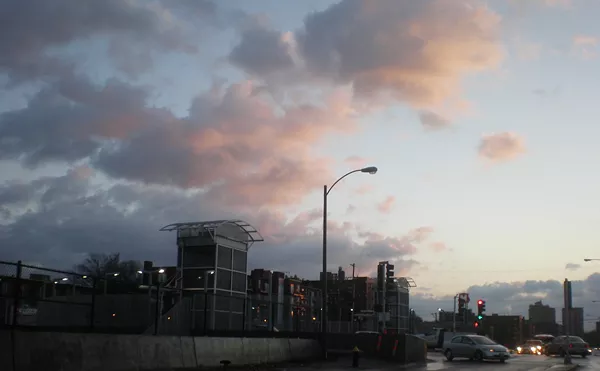The store's massive curved concrete facade fronted the northeast corner of two of the busiest streets in the city, beginning at a time when the city's population exceeded 800,000. The store's picture-window displays gave South St. Louis a little taste of downtown, a sign of commercial bustle that eventually faded over the years with the exit of more than 500,000 city residents, the rise of suburban malls and the demise of stand-alone branch department stores. Not so coincidentally, once Famous closed and its rubble was cleared, the vacant lot reinforced the perception that the surrounding neighborhoods weren't what they used to be, as people and money drained out of the city to the more spacious and homogenous suburbs.
Efforts to build on the site, which in the minds of many meant replacing the Famous-Barr with something of similar status, never led to much except for talk of a HQ hardware megastore, but that company's financial problems stalled those plans. Finally, eight years after Southtown Famous closed, Kmart announced plans for a store on the 11-acre lot. All developers needed, because they sought no new public subsidy, was a conditional-use permit from the city, and commerce would once again be rolling at Kingshighway and Chippewa. That's all they needed, but what they got was more than 800 signatures in opposition and a litany of grief from dozens of angry residents voicing their opinions for the record.
The permit hearing, an event usually attended only by applicants who must be there and lawyers paid to be there, was packed with close to 300 citizens. So many people wanted to testify against the proposed Kmart store that the hearing was continued the next week. The second meeting, held March 28, was slightly less crowded, but still about 200 people attended, armed with written statements, charts, copies of studies, demographic statistics and a resolve that Kmart should not be granted the right to build on the corner.
John Koch, the former alderman who has been the zoning administrator for the city for the last five years, says he was surprised by the turnout. Koch hopes to make his recommendation to the Board of Public Service for its decision on April 11. Normally, Koch's recommendation to the Board of Public Service is acted on by the board the same day he presents it. "But, considering the volume of the evidence and testimony that was presented and the intensity of the passion here, the board just might decide to take it under consideration for a short period of time," Koch says.
Koch, a City Hall veteran, knows this has become a loaded issue. In 1997, Mayor Clarence Harmon warned the site's developer, Sansone Holding Co., to do something with the lot in 90 days or else but later backed off from his demands. Sansone had originally packaged the 4-acre Famous lot with an additional 7 acres and sold it to Developers Diversified Realty (DDR) of Cleveland. In July, once HQ went belly-up and its $50,000-per-month lease payment to Sansone stopped, the proposal for a new Kmart at the site started to coalesce. There was talk of relocating the Walgreens from across Chippewa. But the Southside Coalition, a group of more than 20 neighborhood and business associations, didn't like the proposal and looked for alternatives. The coalition leaders say they have found a developer with an alternate proposal, and they want the city to deny Kmart's request for a conditional-use permit.
At the first hearing, Rep. Patrick Dougherty (D-St. Louis) testified against granting Kmart the permit. So did Ald. Stephen Gregali (D-14th). The most dramatic opposition came from Aldermanic President Francis Slay, who is running for mayor next year against Harmon. In his brief statement opposing the Kmart request, Slay said, "This issue is too important to sit idly by and watch from the sidelines." That "sitting idly by" reference is one Slay has used before to describe Harmon. Slay's comments, at several intervals, were greeted with loud applause that may have been audible down the hall in Room 200. Later, during the second meeting, Southside Coalition leader Phil Klevorn turned from the podium to ask whether anyone from the mayor's office was in attendance and whether they wanted to speak. No one responded.
The size of the turnout, and the political weight of the elected officials speaking in opposition, showed how driven the Southside Coalition has become. The issue is a difficult one for Harmon, because if he opposes a Kmart at the site, the lot very well may still be vacant when he runs for office next spring, one more example of a stalled project. If he supports Kmart, he risks alienating a vocal and active group in his power base of South St. Louis. Because Koch's recommendation goes to the Board of Public Service, made up entirely of mayoral appointees, Harmon's position carries some weight. Ultimately, appeals could put the question before a St. Louis Circuit Court judge, with whom direct political intervention is unlikely. On Friday, the plot thickened as Gregali wrote St. Louis Development Corp. to request that it begin the process to obtain the property through eminent domain.
Whatever the outcome, the packed hearings turned some heads at City Hall. After the second hearing, Jerome Pratter walked out of the Kennedy Room marveling at the organized opposition he had just witnessed. "It was fabulous," observed Pratter, who is an attorney for the Stolar Partnership, which is working for Kmart. Pratter was referring to the Internet research conducted by the Southside Coalition, the association of neighborhood groups that have rallied together against the proposal. Pratter made it clear that he thought they were misguided but said he admired their drive and ingenuity. Just a few minutes earlier, during the hearing, Pratter had issued an ominous warning to the opponents of Kmart's plan for the Southtown site.
"A woman told me this morning that every present she ever received as a child, from her birthday to Christmas, came from that Southtown Famous store. Well, let me tell you -- that store no longer exists," Pratter told the crowd. Later, he added that those trying to block the Kmart proposal "were taking a gamble," because, if they succeed, the city could end up with two vacant lots, the one at Kingshighway and Chippewa and one at Gravois and Gustine avenues, because Kmart plans to close its store at Gravois Plaza.
Gregali, Klevorn and the Southside Coalition have a different plan for the long-empty corner, and Kmart is not a part of it. Instead of one "big-box" development, they envision two or three smaller stores, something along the lines of an Old Navy, Circuit City or T.J. Maxx, connected by smaller storefronts featuring the likes of a St. Louis Bread Co. or other small stores and restaurants. In their plan, the stores would be close to the street and the parking would be behind the stores -- still free, just not as visible from the street. The bricks and architecture would be more suited to the surrounding apartments and businesses, similar to the strip on South Grand Boulevard at Arsenal Street.
To this end, they have been in contact with Jeffrey Anderson, a developer from Cincinnati. Anderson has visited the site, even lunching at the Applebee's across the street, and has expressed interest in developing the site. Gregali and Todd Britt, an aide to Slay, traveled to Cincinnati to meet with Anderson and tour his developments. Klevorn believes having two or three retail anchors along with smaller ventures gives a more varied mix to the development. Depending too much on one large discount retailer, particularly the somewhat financially troubled Kmart, is riskier, says Klevorn, and doesn't fit the neighborhood.
"This is a big-box concept," Klevorn says. "This is a Manchester Road concept they're trying to put in an urban environment. We're opposed to the idea of taking the second-busiest corner in the city, a prime location, and not developing that in a manner that adds to the neighborhood. We already have a Kmart. This is just shifting it and giving Kmart a competitive advantage."
Much of the tone of the two days of testimony by opponents dealt with the reputation of Kmart's store at Gravois Plaza, which is less than a mile-and-a-half away from the Southtown site. Many called Kmart a "bad neighbor" for letting that store's merchandise and customer service decline.
Gregali says Kmart has been telling him it will close the Gravois Plaza store for the last three years, so he's not sure it's anything more than talk. During the hearings, Kmart spokesmen said that whatever happens with the Southtown proposal, they do plan to close the Gravois Plaza store "due to declining sales, inefficiencies of operation and site limitations." Gregali says that Kimco Realty Corp., the owner of Gravois Plaza, has offered to raze much of the minimall to enhance and expand Kmart's store there but Kmart has refused to discuss the offer. Kmart denies that any real written offer has been made.
What Kmart has done is suggest that if they get the Southtown site, the company might consider placing a store in North St. Louis. Just who originally brought this up is unclear -- no one seems to want to claim authorship of the idea. The closest it has come to being stated in any clear way was on the postcard the owners of the site, DDR, sent to area residents. In citing the reasons the Kmart proposal should be granted, the seventh and last reason listed was this: "This store is a key component of Kmart's overall strategy for the entire City of St. Louis."
Bill Kuehling, an attorney hired by Kmart, says Harmon brought up the idea of a North St. Louis Kmart. Gregali says a representative of Sansone Holding Co. brought it up. Either way, the linking of a possible, as-yet-unspecified North St. Louis project to the approval of South St. Louis project rubs Gregali and others the wrong way.
"I'm insulted by that," says Gregali of the proposed trade-off, saying it "drives a wedge between north and south" St. Louis. There should be no connection between Koch's recommendation and the idea that Kmart "might consider building a store in North St. Louis." Gregali insists that the opposition to the current proposal isn't so much anti-Kmart as it is wanting a better use for the Southtown site. "We don't want Kmart to leave. It's in the same neighborhood," says Gregali. "We want them to stay, but at a redeveloped site."
If South St. Louis isn't what it used to be, it's still struggling to find out what it needs to become. For all the talk of people leaving, Southside Coalition members cited demographic numbers, some downloaded from DDR's own Web site, to show that the population within a five-mile radius of the Southtown site compares favorably with that in suburban sites, including a DDR development at Watson Road and Lindbergh Boulevard in Sunset Hills. Klevorn claims that as a result of density, there are four times as many households with an income of more than $50,000 within five miles of Southtown than there are around the Sunset Hills site, even though the average household income in the suburban site is $70,863, compared with the Southtown site's average of $49,475.
That may be, but the spear-carriers for Kmart just think the coalition is way too optimistic about what can happen at Kingshighway and Chippewa.
"There's a lot of risk involved here," says Kuehling. "DDR are businesspeople. They would love to find users for the site. They would love for there to be five or six different people competing to go in on that site. But the fact of the matter is, there isn't. They're not there."
Kuehling has his own memories of Southtown Famous. As Klevorn was growing up in West County, off Manchester Road, Kuehling was growing up on Tower Grove Place, within walking distance of the Southtown Famous. "I wish you could bring it back," Kuehling says. "I'd love to be able to go to Famous Southtown and go to the candy counter that was on the first floor. I shopped there from the time I could remember -- my mom would drag my brothers and me up there. But it closed up. And it's not coming back. And they're not going to get Ladue Crossing or something in there. I wish they could, but I just don't see it. It's not viable."
Whatever is or is not possible, Gregali is optimistic. He likens the current process to a similar one that occurred years ago, when Huck's, a convenience store and sandwich shop, wanted to locate at the southeast corner of Kingshighway and Chippewa. Claiming it would not "promote the general welfare," Gregali and others opposed the conditional-use permit. It was denied, and later an Applebee's, a sit-down restaurant, was built. It has thrived. Gregali appears fixated on stopping the Kmart proposal.
"This is just as important as the downtown convention hotel. We're talking about stabilizing a neighborhood," says Gregali. "But the mayor doesn't have the enthusiasm for it. If he did, he would have had someone over there speaking for us." That the development of the site stayed adrift for all the years Sansone had the lease with HQ is a sign that the mayor's office didn't act, Gregali contends. And it's a bit late, Gregali says, for Harmon to worry that blocking the Kmart plan will make it look as if nothing is happening at the site.
"Shame on him for sitting back and not doing anything about it. If he's so worried about what the public is going to think if he didn't do anything, my answer to that is that he didn't do anything. To sit back and have some developer come and say, 'Well, this is as good as it gets,' and for him to accept it, that certainly doesn't show a sign of leadership," Gregali says.
"This thing on that corner is just as important as that damn hotel downtown," Gregali adds. "In fact, nobody who's going to reside in that hotel for a day at a time is going to vote for anybody downtown. I got 3,000 people in my neighborhood who are going to vote. They're the same people who brought this guy in and they can take him out. If he doesn't get on the right side of this issue, he will not be mayor in a year."
Ald. Craig Schmid (D-10th) doesn't see what the difficulty is. At a Metropolis St. Louis-sponsored cleanup at the site on Saturday, Schmid said that for a politician, this issue should be a "no-brainer. You go with the people."
After Koch's recommendation, the Board of Public Service makes its ruling. Upon appeal, that decision would be reviewed by the Board of Adjustment. An appeal of that decision would put the issue before a circuit judge, so the process could take months. If Kmart prevails and does what it says it will, the Gravois Plaza store will be closed and the few stores remaining at that site will suffer. If Kmart fails, it could abandon the city altogether, except for its troubled store at St. Louis Marketplace near McCausland and Manchester. The stakes in the decision, both symbolic and real, are high.
"This is the biggest economic decision that has been made in South St. Louis in the last 20 years," says Klevorn. "If we don't develop this wisely and smartly, then we have told the whole St. Louis metropolitan area that the best South St. Louis can do is a Kmart. If that's the best we can do, then the word is out that we're a declining community."





